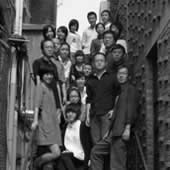The park designed by Ábalos + Sentkiewicz Arquitectos and Atelier L+ has been built on the banks of the Huangpu River, 400 meters wide through which an intense fluvial traffic of raw materials circulates with the city of Nanjing, the ancient capital of China has been proposed as an Environmental System that proposes to efficiently organize five complementary and integrated subsystems: the Green System, the Memory System, the Water System, the Knowledge System and the Infrastructure System, a set of ideas that want to convert the area in the first self-sufficient large urban sector of Shanghai.
The project is considered an activator that facilitates the best nature-city integration, facilitates the decarbonization of the area and recovers the memory of the city and the relationship with the river, taking advantage of the best solar orientation, the best views of the bridge, the river, and the downtown Shanghai skyline.
A natural space that will be the centre of urban development of two million square meters of new construction, and the restoration of another half million square meters dedicated to cultural and leisure uses.
The park project is completed with a transport connection area, ferry-metro-bus-taxi-parking organized by means of a gallery in which a leisure and commerce program (theatre, restaurants, shops, etc.) is developed.

Yangpu Bridge Riverside Area by Ábalos + Sentkiewicz and Atelier L+. Photograph by Zhang Yong.

Yangpu Bridge Riverside Area by Ábalos + Sentkiewicz and Atelier L+. Photograph by Zhang Yong.
Description of project by Ábalos + Sentkiewicz Arquitectos and Atelier L+
The project marks the first phase of a transformation process that will affect a large-scale plot around the Yangpu Bridge. The project entails the creation of a Central Park and, revolving around it, the urban development of two million square meters of new construction and the restoration of another half million square meters dedicated to cultural and leisure uses, intervening in the industrial buildings that are located facing the Huangpu River, whose 400-meter width is still dedicated to the fluvial traffic of raw materials with Nanjing, the ancient capital of China. It is a strategic project in the memory of the city since the industrialization process of China began here with the implantation of warehouses for the textile industry (and the incorporation of women into the world of work). The entire project has been thought of as an Environmental System that efficiently organizes five complementary and integrated subsystems: the Green System, the Memory System, the Water System, the Knowledge System and the Infrastructure System, so that the whole it will become the first self-sufficient large urban sector in Shanghai, designed from the point of view of nature-city integration, decarbonization and enhancing the memory of the city and the river.

Yangpu Bridge Riverside Area by Ábalos + Sentkiewicz and Atelier L+. Photograph by Zhang Yong.
The construction of the Park represents the first phase of the project that won an international competition carried out by AS+ and developed in collaboration with Atelier L+ and TJAD engineering. The project overlaps two sectors, the Intermodal that consists of a ferry-metro-bus-taxi-parking connection organized through a gallery with an amenities area (theater, restaurants, shops…), and the park itself that serves as a leisure area and expansion to the new tertiary and cultural center to be built, in part rehabilitating the historic building, as well as serving the large residential area to be built in the immediate surroundings. The location of the park takes advantage of the best solar orientation and the best views of the bridge, the river and downtown Shanghai skyline.
Second phase Carbon Park
Changes in the political structure during the COVID break have affected the following phases with which they will end up incorporating the park project into the new sports infrastructure aimed at increasing the inclusion of ice sports and slightly rethinking other programs, also incorporating into the design team to architects such as Liu Yichun (Dehaus) and Philip Yuan (Archi-Union), with which we have the honor of working with one of the best representatives of contemporary Chinese architecture, keeping TJAD as the main engineering.



















































